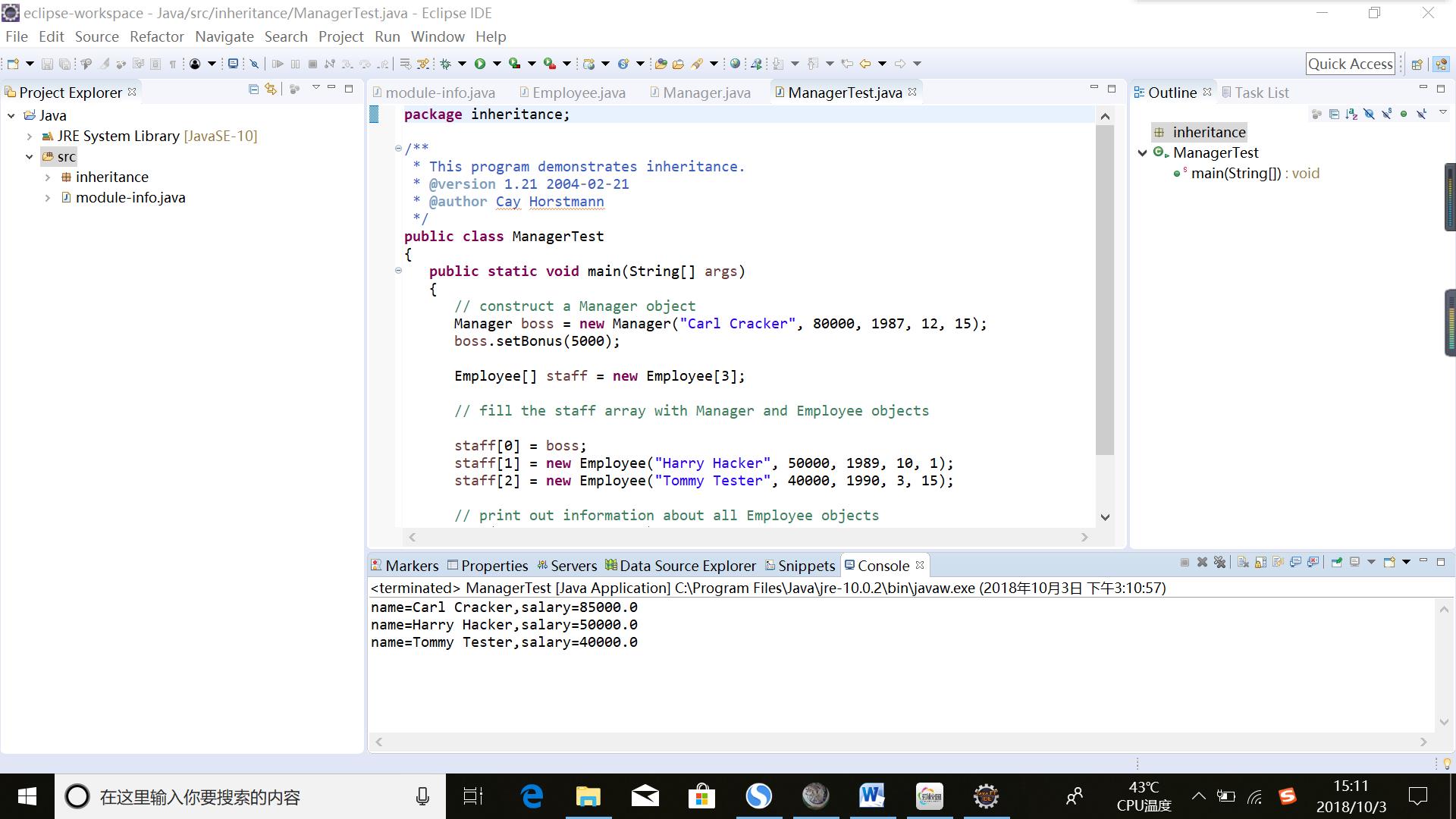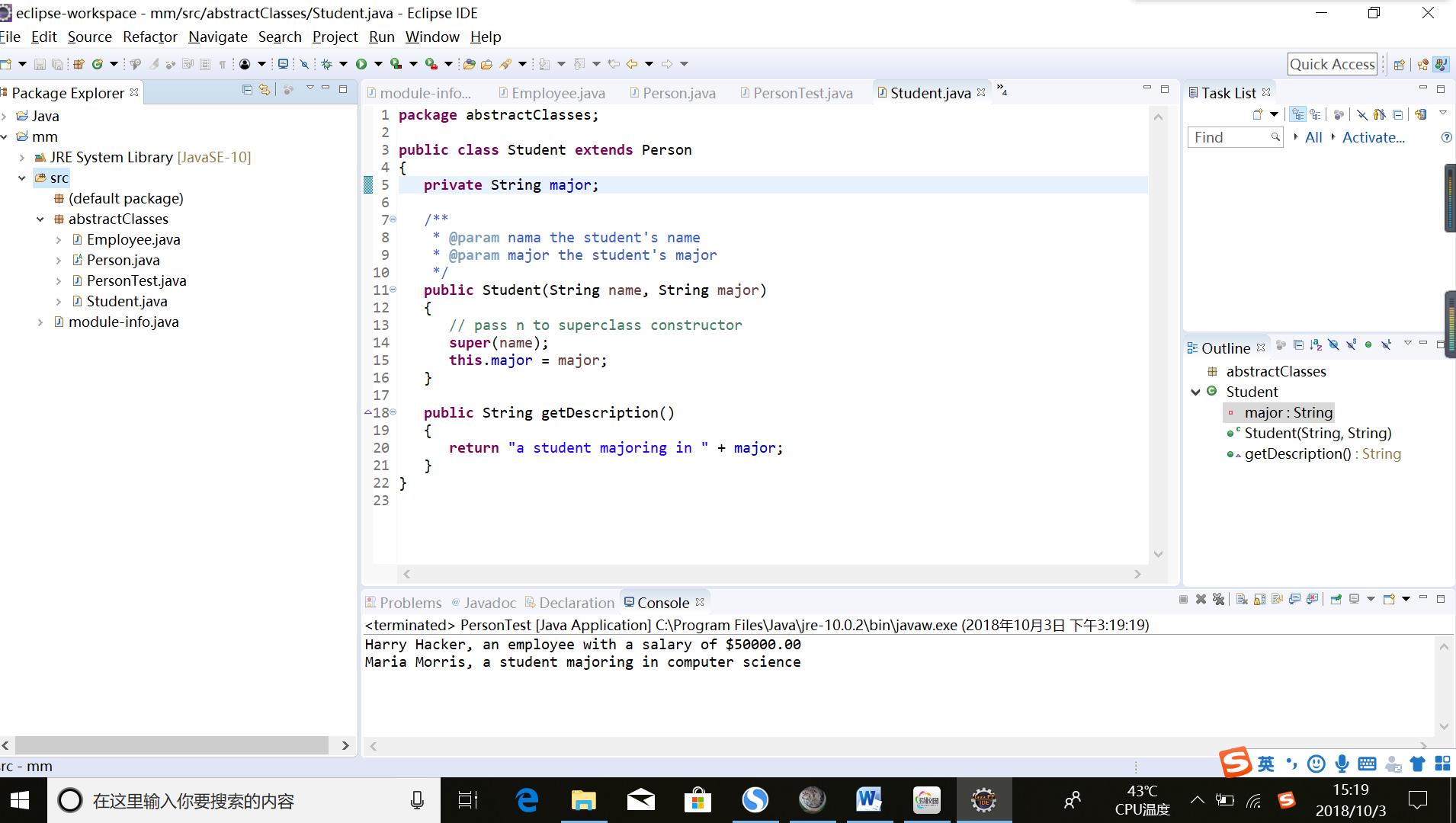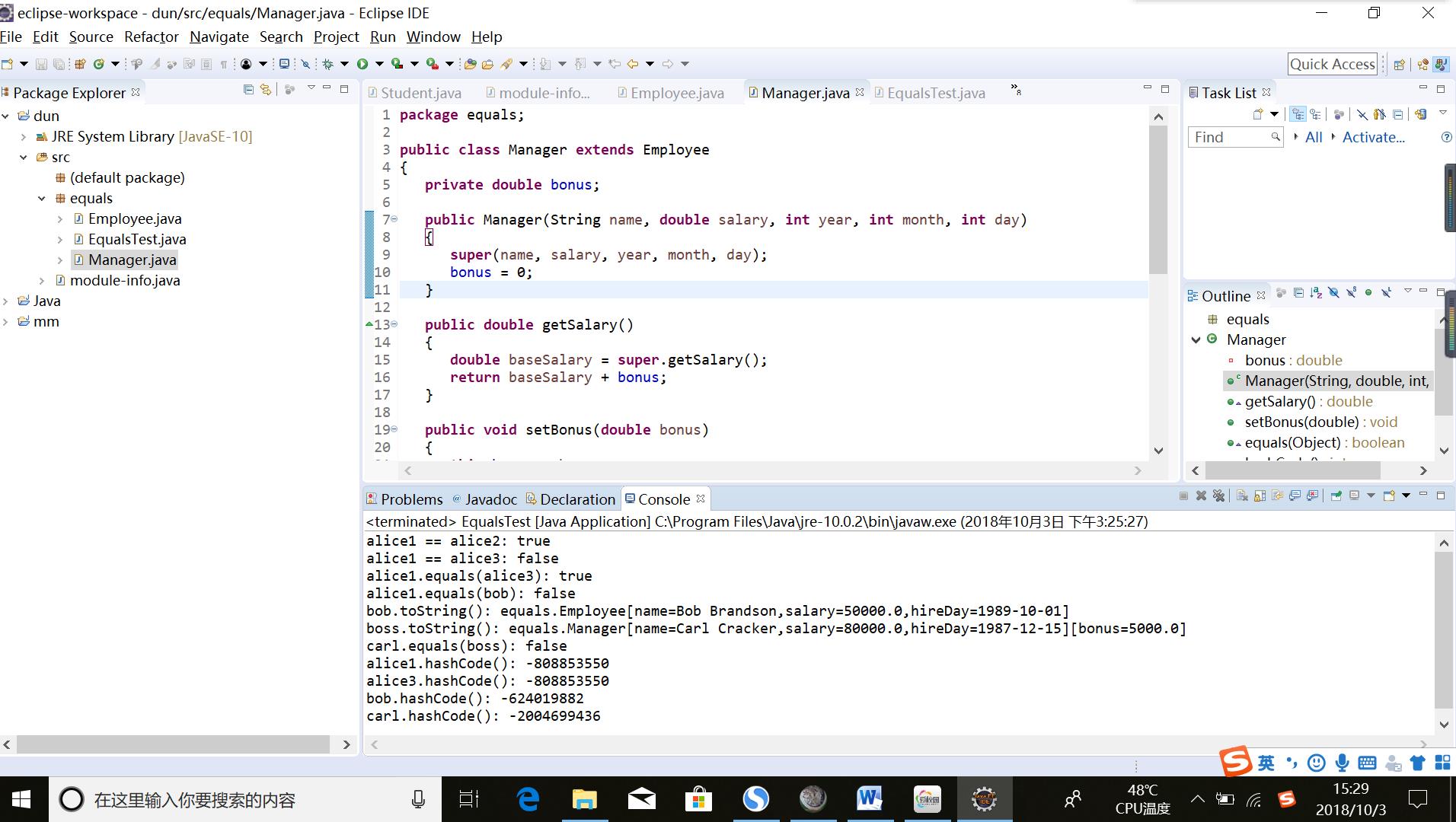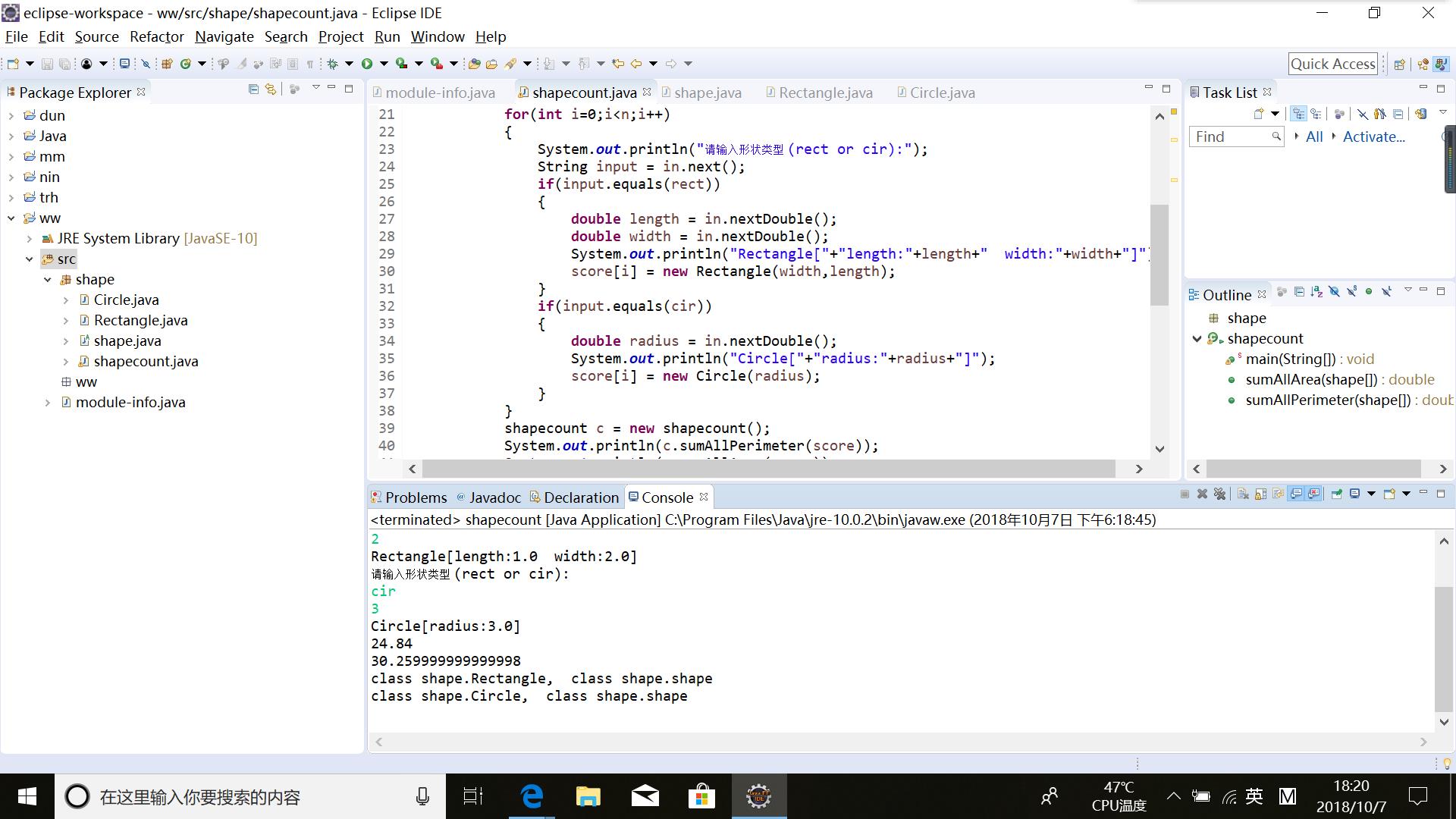201771010106东文财《面向对象程序设计(java)》 实验6
Posted Mnnnnn£
tags:
篇首语:本文由小常识网(cha138.com)小编为大家整理,主要介绍了201771010106东文财《面向对象程序设计(java)》 实验6相关的知识,希望对你有一定的参考价值。
实验六继承定义与使用
实验时间 2018-9-28
一.知识总结
1、继承的概述:在多个类中存在相同的属性和行为,把这些相同的部分抽取到一个单独的类中,把这个单独的类叫作父类,也叫基类或者超类,把其他被抽取的类叫作子类,并且父类的所有属性和方法(除private修饰的私有属性和方法外),子类都可以调用。这样的一种行为就叫做继承。(相同的东西在父类,不同的东西在子类)
2、继承的关键字:extends
3、继承的格式:class 子类名 extends 父类名{ }
4、在代码中使用继承提高了代码的复用性和维护性,让类与类直接产生了关系。
5、继承的注意点:
①子类只能继承父类所有的非私有的成员方法和成员变量,private修饰的不能继承。
②子类不能继承父类的构造方法,但可以通过 super 关键字去访问父类的构造方法。(先初始化父类,再执行自己)
③不同包不能继承。
6、在使用 super 的时候,我们还需要了解关键字 super 和 this 的区别:
super :到父类中去找方法,没有引用的作用;也可以用于其他方法中;与this调用构造方的重载一样,用于第一行。
this:是指当前正在初始化的这个对象的引用。
二.实验部分:
1、实验目的与要求
(1) 理解继承的定义;
(2) 掌握子类的定义要求
(3) 掌握多态性的概念及用法;
(4) 掌握抽象类的定义及用途;
(5) 掌握类中4个成员访问权限修饰符的用途;
(6) 掌握抽象类的定义方法及用途;
(7)掌握Object类的用途及常用API;
(8) 掌握ArrayList类的定义方法及用法;
(9) 掌握枚举类定义方法及用途。
2、实验内容和步骤
实验1: 导入第5章示例程序,测试并进行代码注释。
测试程序1:
在elipse IDE中编辑、调试、运行程序5-1 (教材152页-153页) ;
掌握子类的定义及用法;
结合程序运行结果,理解并总结OO风格程序构造特点,理解Employee和Manager类的关系子类的用途,并在代码中添加注释。
package inheritance; import java.time.*; public class Employee { private String name; private double salary; private LocalDate hireDay; //构建三个私有对象 public Employee(String name, double salary, int year, int month, int day) { this.name = name; this.salary = salary; hireDay = LocalDate.of(year, month, day); } public String getName() { return name; } public double getSalary() { return salary; } public LocalDate getHireDay() { return hireDay; } public void raiseSalary(double byPercent) { double raise = salary * byPercent / 100; salary += raise; } }
package inheritance; public class Manager extends Employee
//关键字extends表示继承。表明正在构造一个新类派生于一个已经存在的类。已经存在的类称为超类/基类/或者父类;新类称为子类/派生类/或者孩子类。 { private double bonus; /** * @param name the employee\'s name * @param salary the salary * @param year the hire year * @param month the hire month * @param day the hire day */ public Manager(String name, double salary, int year, int month, int day) { super(name, salary, year, month, day);
//调用超类中含有n,s,year,month,day参数的构造器 bonus = 0; } public double getSalary()
//子类要想访问要想访问超类中的方法需要使用特定的关键字super, { double baseSalary = super.getSalary(); return baseSalary + bonus; } public void setBonus(double b) { bonus = b; } }
package inheritance; /** * This program demonstrates inheritance. * @version 1.21 2004-02-21 * @author Cay Horstmann */ public class ManagerTest { public static void main(String[] args) { // 构建管理者对象 Manager boss = new Manager("Carl Cracker", 80000, 1987, 12, 15); boss.setBonus(5000); Employee[] staff = new Employee[3]; // 用管理者和雇员对象填充工作人员数组 staff[0] = boss; staff[1] = new Employee("Harry Hacker", 50000, 1989, 10, 1); staff[2] = new Employee("Tommy Tester", 40000, 1990, 3, 15); // 打印所有员工对象的信息 for (Employee e : staff) System.out.println("name=" + e.getName() + ",salary=" + e.getSalary()); } }
实验结果:

测试程序2:
编辑、编译、调试运行教材PersonTest程序(教材163页-165页);
掌握超类的定义及其使用要求;
掌握利用超类扩展子类的要求;
在程序中相关代码处添加新知识的注释。
package abstractClasses; import java.time.*; public class Employee extends Person { private double salary; private LocalDate hireDay; public Employee(String name, double salary, int year, int month, int day) { super(name); this.salary = salary; hireDay = LocalDate.of(year, month, day); } public double getSalary() { return salary; } public LocalDate getHireDay() { return hireDay; } //重写父类方法,返回一个格式化的字符串 public String getDescription() { return String.format("an employee with a salary of $%.2f", salary); } public void raiseSalary(double byPercent) { double raise = salary * byPercent / 100; salary += raise; } }
package abstractClasses; public abstract class Person {
//包含一个或多个抽象方法的类被称为抽象类,由abstract关键字修饰 public abstract String getDescription(); private String name; public Person(String name) { this.name = name; } public String getName() { return name; } }
package abstractClasses; /** * This program demonstrates abstract classes. * @version 1.01 2004-02-21 * @author Cay Horstmann */ public class PersonTest { public static void main(String[] args) {
//抽象类的声明,但不能将抽象类实例化 ,实例化的是Person类的子类 Person[] people = new Person[2]; // 用学生和雇员填充人物数组
people[0] = new Employee("Harry Hacker", 50000, 1989, 10, 1); people[1] = new Student("Maria Morris", "computer science"); // 打印所有人对象的名称和描述 for (Person p : people) System.out.println(p.getName() + ", " + p.getDescription()); } }
package abstractClasses; public class Student extends Person { private String major; /** * @param nama the student\'s name * @param major the student\'s major */ public Student(String name, String major) { // 通过n to 总纲构造函数 super(name); this.major = major; } public String getDescription() { return "a student majoring in " + major; } }
实验结果:

测试程序3:
编辑、编译、调试运行教材程序5-8、5-9、5-10,结合程序运行结果理解程序(教材174页-177页);
掌握Object类的定义及用法;
在程序中相关代码处添加新知识的注释。
package equals; import java.time.*; import java.util.Objects; public class Employee { private String name; private double salary; private LocalDate hireDay; public Employee(String name, double salary, int year, int month, int day) { this.name = name; this.salary = salary; hireDay = LocalDate.of(year, month, day); } public String getName() { return name; } public double getSalary() { return salary; } public LocalDate getHireDay() { return hireDay; } public void raiseSalary(double byPercent) { double raise = salary * byPercent / 100; salary += raise; } public boolean equals(Object otherObject) { //这里获得一个对象参数,第一个if语句判断两个引用是否是同一个,如果是那么这两个对象肯定相等 if (this == otherObject) return true; // 如果显式参数为空,则必须返回false if (otherObject == null) return false; // if the classes don\'t match, they can\'t be equal if (getClass() != otherObject.getClass()) return false; // 现在我们知道另一个对象是非空雇员 Employee other = (Employee) otherObject; // test whether the fields have identical values return Objects.equals(name, other.name) && salary == other.salary && Objects.equals(hireDay, other.hireDay); } public int hashCode() { return Objects.hash(name, salary, hireDay); } public String toString()// toString()方法 { return getClass().getName() + "[name=" + name + ",salary=" + salary + ",hireDay=" + hireDay + "]"; } }
package equals; /** * This program demonstrates the equals method. * @version 1.12 2012-01-26 * @author Cay Horstmann */ public class EqualsTest { public static void main(String[] args) { Employee alice1 = new Employee("Alice Adams", 75000, 1987, 12, 15); Employee alice2 = alice1; Employee alice3 = new Employee("Alice Adams", 75000, 1987, 12, 15); Employee bob = new Employee("Bob Brandson", 50000, 1989, 10, 1); System.out.println("alice1 == alice2: " + (alice1 == alice2)); System.out.println("alice1 == alice3: " + (alice1 == alice3)); System.out.println("alice1.equals(alice3): " + alice1.equals(alice3)); System.out.println("alice1.equals(bob): " + alice1.equals(bob)); System.out.println("bob.toString(): " + bob); Manager carl = new Manager("Carl Cracker", 80000, 1987, 12, 15); Manager boss = new Manager("Carl Cracker", 80000, 1987, 12, 15); boss.setBonus(5000); System.out.println("boss.toString(): " + boss); System.out.println("carl.equals(boss): " + carl.equals(boss)); System.out.println("alice1.hashCode(): " + alice1.hashCode()); System.out.println("alice3.hashCode(): " + alice3.hashCode()); System.out.println("bob.hashCode(): " + bob.hashCode()); System.out.println("carl.hashCode(): " + carl.hashCode()); } }
package equals; public class Manager extends Employee { private double bonus; public Manager(String name, double salary, int year, int month, int day) { super(name, salary, year, month, day); bonus = 0; } public double getSalary() { double baseSalary = super.getSalary(); return baseSalary + bonus; } public void setBonus(double bonus) { this.bonus = bonus; } public boolean equals(Object otherObject) { if (!super.equals(otherObject)) return false; Manager other = (Manager) otherObject; // 检查这个和其他属于同一个类 return bonus == other.bonus; } public int hashCode() { return java.util.Objects.hash(super.hashCode(), bonus); } public String toString() { return super.toString() + "[bonus=" + bonus + "]"; } }
实验结果:

测试程序4:
在elipse IDE中调试运行程序5-11(教材182页),结合程序运行结果理解程序;
掌握ArrayList类的定义及用法;
在程序中相关代码处添加新知识的注释。
package arrayList; import java.util.*; /** * This program demonstrates the ArrayList class. * @version 1.11 2012-01-26 * @author Cay Horstmann */ public class ArrayListTest { public static void main(String[] args) { // 用三个雇员对象填充工作人员数组列表
ArrayList<Employee> staff = new ArrayList<>(); staff.add(new Employee("Carl Cracker", 75000, 1987, 12, 15)); staff.add(new Employee("Harry Hacker", 50000, 1989, 10, 1)); staff.add(new Employee("Tony Tester", 40000, 1990, 3, 15)); //把每个人的薪水提高5% for (Employee e : staff) e.raiseSalary(5); // 打印所有员工对象的信息 for (Employee e : staff) System.out.println("name=" + e.getName() + ",salary=" + e.getSalary() + ",hireDay=" + e.getHireDay()); } }
package arrayList; import java.time.*; public class Employee { private String name; private double salary; private LocalDate hireDay; public Employee(String name, double salary, int year, int month, int day) { this.name = name; this.salary = salary; hireDay = LocalDate.of(year, month, day); } public String getName() { return name; } public double getSalary() { return salary; } public LocalDate getHireDay() { return hireDay; } public void raiseSalary(double byPercent) { double raise = salary * byPercent / 100; salary += raise; } }
实验结果:

测试程序5:
编辑、编译、调试运行程序5-12(教材189页),结合运行结果理解程序;
掌握枚举类的定义及用法;
在程序中相关代码处添加新知识的注释。
package enums; import java.util.*; /** * This program demonstrates enumerated types. * @version 1.0 2004-05-24 * @author Cay Horstmann */ public class EnumTest { private static Scanner in; public static void main(String[] args) { in = new Scanner(System.in); System.out.print("Enter a size: (SMALL, MEDIUM, LARGE, EXTRA_LARGE) "); String input = in.next().toUpperCase(); Size size = Enum.valueOf(Size.class, input); System.out.println("size=" + size); System.out.println("abbreviation=" + size.getAbbreviation()); if (size == Size.EXTRA_LARGE) System.out.println("Good job--you paid attention to the _."); } } enum Size { SMALL("S"), MEDIUM("M"), LARGE("L"), EXTRA_LARGE("XL"); private Size(String abbreviation) { this.abbreviation = abbreviation; } public String getAbbreviation() { return abbreviation; } private String abbreviation; }
实验结果:

实验2:编程练习1
定义抽象类Shape:
属性:不可变常量double PI,值为3.14;
方法:public double getPerimeter();public double getArea())。
让Rectangle与Circle继承自Shape类。
编写double sumAllArea方法输出形状数组中的面积和和double sumAllPerimeter方法输出形状数组中的周长和。
main方法中
1)输入整型值n,然后建立n个不同的形状。如果输入rect,则再输入长和宽。如果输入cir,则再输入半径。
2) 然后输出所有的形状的周长之和,面积之和。并将所有的形状信息以样例的格式输出。
3) 最后输出每个形状的类型与父类型,使用类似shape.getClass()(获得类型),shape.getClass().getSuperclass()(获得父类型);
思考sumAllArea和sumAllPerimeter方法放在哪个类中更合适?
输入样例:
3
rect
1 1
rect
2 2
cir
1
输出样例:
18.28
8.14
[Rectangle [width=1, length=1], Rectangle [width=2, length=2], Circle [radius=1]]
class Rectangle,class Shape
class Rectangle,class Shape
class Circle,class Shape
package shape; import java.math.*; import java.util.*; import shape.shape; import shape.Rectangle; import shape.Circle; public class shapecount { public static void main(String[] args) { Scanner in = new Scanner(System.in); String rect = "rect"; String cir = "cir"; System.out.print("请输入形状个数:"); int n = in.nextInt(); shape[] score = new shape[n]; for(int i=0;i<n;i++) { System.out.println("请输入形状类型 (rect or cir):"); String input = in.next(); if(input.equals(rect)) { double length = in.nextDouble(); double width = in.nextDouble(); System.out.println("Rectangle["+"length:"+length+" width:"+width+"]"); score[i] = new Rectangle(width,length); } if(input.equals(cir)) { double radius = in.nextDouble(); System.out.println("Circle["+"radius:"+radius+"]"); score[i] = new Circle(radius); } } shapecount c = new shapecount(); System.out.println(c.sumAllPerimeter(score)); System.out.println(c.sumAllArea(score)); for(shape s:score) { System.out.println(s.getClass()+", "+s.getClass().getSuperclass()); } } public double sumAllArea(shape score[]) { double sum = 0; for(int i = 0;i<score.length;i++) sum+= score[i].getArea(); return sum; } public double sumAllPerimeter(shape score[]) { double sum = 0; for(int i = 0;i<score.length;i++) sum+= score[i].getPerimeter(); return sum; } }
package shape; public class Rectangle extends shape { private double width; private double length; public Rectangle(double w,double l) { this.width = w; this.length = l; } public double getPerimeter() { double Perimeter = (width+length)*2; return Perimeter; } public double getArea() { double Area = width*length; return Area; } public String toString() { return getClass().getName() + "[ width=" + width + "]"+ "[length=" + length + "]"; } }
package shape; public abstract class shape { double PI = 3.14; public abstract double getPerimeter(); public abstract double getArea(); }
package shape; public class Circle extends shape { private double radius; public Circle(double r) { radius = r; } public double getPerimeter() { double Perimeter = 2*PI*radius; return Perimeter; } public double getArea() { double Area = PI*radius*radius; return Area; } public String toString() { return getClass().getName() + "[radius=" + radius + "]"; } }
实验结果:

实验3:编程练习2
编制一个程序,将身份证号.txt 中的信息读入到内存中,输入一个身份证号或姓名,查询显示查询对象的姓名、身份证号、年龄、性别和出生地。
package qq; import java.io.BufferedReader; import java.io.File; import java.io.FileInputStream; import java.io.FileNotFoundException; import java.io.IOException; import java.io.InputStreamReader; import java.util.ArrayList; import java.util.Scanner; public class Test{ private static ArrayList<Citizen> citizenlist; public static void main(String[] args) { citizenlist = new ArrayList<>(); Scanner scanner = new Scanner(System.in); File file = new File("D:\\\\身份证号.txt"); try { FileInputStream fis = new FileInputStream(file); BufferedReader in = new BufferedReader(new InputStreamReader(fis)); String temp = null; while ((temp = in.readLine()) != null) { Scanner linescanner = new Scanner(temp); linescanner.useDelimiter(" "); String name = linescanner.next(); String id = linescanner.next(); String sex = linescanner.next(); String age = linescanner.next(); String address =linescanner.nextLine(); Citizen citizen = new Citizen(); citizen.setName(name); citizen.setId(id); citizen.setSex(sex); citizen.setAge(age); citizen.setAddress(address); citizenlist.add(citizen); } } catch (FileNotFoundException e) { System.out.println("信息文件找不到"); e.printStackTrace(); } catch (IOException e) { System.out.println("信息文件读取错误"); e.printStackTrace(); } boolean isTrue = true; while (isTrue) { System.out.println("1.按姓名查询"); System.out.println("2.按身份证号查询"); System.out.println("3.退出"); int nextInt = scanner.nextInt(); switch (nextInt) { case 1: System.out.println("请输入姓名"); String citizenname = scanner.next(); int nameint = findCitizenByname(citizenname); if (nameint != -1) { System.out.println("查找信息为:身份证号:" + citizenlist.get(nameint).getId() + " 姓名:" + citizenlist.get(nameint).getName() +" 性别:" +citizenlist.get(nameint).getSex() +" 年龄:" +citizenlist.get(nameint).getAge()+" 地址:" +citizenlist.get(nameint).getAddress() ); } else { System.out.println("不存在该公民"); } break; case 2: System.out.println("请输入身份证号"); String citizenid = scanner.next(); int idint = findCitizenByid(citizenid); if (idint != -1) { System.out.println("查找信息为:身份证号:" + citizenlist.get(idint ).getId() + " 姓名:" + citizenlist.get(idint ).getName() +" 性别:" +citizenlist.get(idint ).getSex() +" 年龄:" +citizenlist.get(idint ).getAge()+" 地址:" +citizenlist.get(idint ).getAddress() ); } else { System.out.println("不存在该公民"); } break; case 3: isTrue = false; System.out.println("程序已退出!"); break; default: System.out.println("输入有误"); } } } public static int findCitizenByname(String name) { int flag = -1; int a[]; for (int i = 0; i < citizenlist.size(); i++) { if (citizenlist.get(i).getName().equals(name)) { flag=以上是关于201771010106东文财《面向对象程序设计(java)》 实验6的主要内容,如果未能解决你的问题,请参考以下文章201771010106东文财《面向对象程序设计(java)》 实验8
201771010106东文财《面向对象程序设计(java)》实验9
东文财 赵栋 罗松 201771010106《面向对象程序设计(java)》实验14
201771010106东文财《面向对象程序设计(java)》 实验6